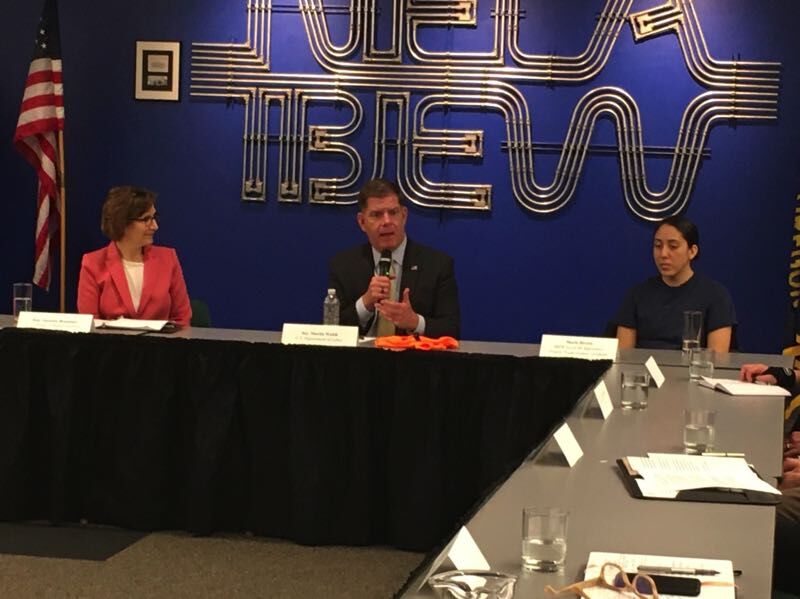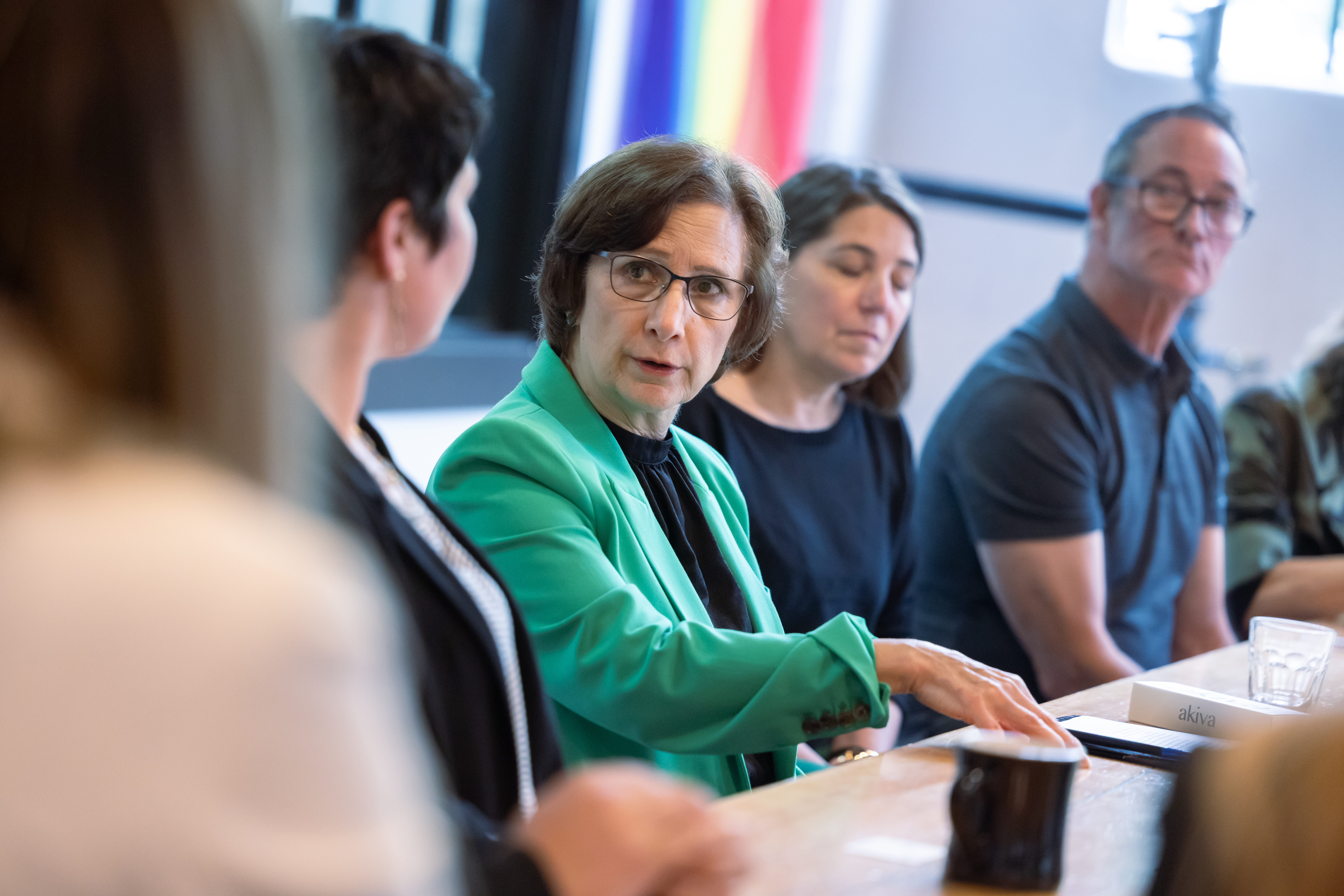Labor secretary praises Oregon’s newest job training plan
Published 9:21 am Monday, March 28, 2022

- Labor Secretary Marty Walsh, center, flanked by U.S. Rep. Suzanne Bonamici, left, and apprentice Maria Rivera at a panel discussion Thursday, March 24, at the Electrical Training Center run by the International Brotherhood of Electrical Workers and National Electrical Contractors Association on Northeast Airport Way in Portland.
U.S. Labor Secretary Marty Walsh says Oregon is on the right track in spending federal and state dollars to train future workers, not just build today’s projects to achieve carbon-free energy and rebuild transportation and communications networks.
Walsh got to see for himself on Thursday, March 24, when he toured the Electrical Training Center on Airport Way in Northeast Portland and spoke with women apprentices from Local 48 of the International Brotherhood of Electrical Workers. Earlier, he visited the Oregon Manufacturing Innovation Center, which Portland Community College operates in Scappoose.
Walsh’s visit, his second to Oregon since the former Boston mayor assumed his Cabinet position a year ago, came just after the Oregon Legislature passed and Gov. Kate Brown signed a $200 million plan known as Future Ready Oregon. The plan focuses on three growing sectors — health care, construction and manufacturing, each with at least 10,000 unfilled jobs as of fourth quarter 2021 — and seeks women, minorities, rural and low-income residents, and others who did not share equally in previous economic recoveries.
“You are making an upfront investment in these programs,” Walsh said after a panel discussion at the Portland training center, which is also sponsored by the National Electrical Contractors Association. “People who go through them get jobs. You strengthen industry, attract new business to this state, increase your tax base and put more money back into the system.
“These are investments we should have done in this country 30 years ago, but we didn’t. But this administration in Washington and this state are committed. This is how we bring manufacturing back to the United States.”
Before he was elected mayor of Boston in 2013 — he resigned in the final year of his second term to accept President Joe Biden’s appointment — Walsh was a Massachusetts state representative for 16 years, and for two of those years led Boston Building Trades. He followed his father into Laborers Local 223. Walsh is the first former union official to lead the Labor Department in almost 50 years.
Oregon’s latest job training plan, which won solid bipartisan support, combines $76 million from the state’s tax-supported general fund with $123 million in federal funds from the American Rescue Plan Act, Biden’s $2 trillion pandemic recovery plan that Congress approved a year ago. The plan emerged from work by the Governor’s Racial Justice Council with support from business, labor and workforce groups.
Part of the money will go toward existing programs run by regional workforce development boards, and part will go to organizations in the form of competitive grants for innovative programs. Some will go to support for would-be workers, such as housing, child care and transportation.
“That is how we are going to open doors for people and families across this state,” Brown said afterward. “We cannot waste this opportunity. Oregon is not going to. Future Ready Oregon is going to be a national model.”
Developing workforce
On March 9, the Labor Department announced a four-year, $6 million grant to three Portland area agencies — including Worksystems Inc., which serves Multnomah and Washington counties — to boost training in health care and information technology under a program known as NW Promise. That plan targets some of the same groups as Future Ready Oregon.
Kelly Haines, project manager for the construction/infrastructure section of Worksystems, said the agency also is spending $1 million to develop a pre-apprenticeship program for Washington County. “We know there is a worker shortage in construction,” she said. “We know there is good opportunity for people.”
Two other congressional bills also affect job training, although a renewal of a revised National Apprenticeship Act, which dates back to 1937, is pending in a Senate committee. It cleared the House more than a year ago. It would authorize up to $1 billion in new apprenticeships, although actual spending is separate.
The other is the $1 trillion Infrastructure Investment and Jobs Act, which Biden signed on Nov. 15. The law provides money not only for road and bridge repairs but also broadband expansion, power grid updates and a growing network of charging stations for electric vehicles.
“We need people to do that work,” said U.S. Rep. Suzanne Bonamici, a Democrat from northwest Oregon’s 1st District who sits on the House Education and Labor Committee and a select panel on climate change. “Having pre-apprenticeship programs and apprenticeships are going to help people get those good-paying union jobs that will be available as we build and rebuild.”
As a member of the tax-writing House Ways and Means Committee, U.S. Rep. Earl Blumenauer proposed several measures to boost public works spending during his 25 years in Congress. He said the appearance of women apprentices spoke volumes about where the workforce was headed.
“For the first time in my career, we have an administration that actually believes in rebuilding and renewing America,” said Blumenauer, a Democrat whose 3rd District takes in the training center.
“The more women we have on the front lines changes the way the public reacts. What you are doing is unlocking the potential of our country.”
Apprentices react
During the tour of the electrical training center, two women were asked how they learned about apprenticeships. Both said it was a matter of happenstance.
“I was not told as a woman that I could go into this field,” Jamie Jarrett said. “It wasn’t until much later that I stumbled across it. So I think awareness at a lower level is important.”
Ashley Gift added: “I think also hearing it from women is important… especially knowing that I could see other women doing it, and I could picture myself doing it.”
To which Gov. Brown replied: “You can’t do what you can’t see.”
During the panel discussion after the tour, Twauna Hennessee, community outreach representative for the Northwest Regional Council of Carpenters, said a barrier remains for people to enter pre-apprenticeship. “Going though a 10-week program without being paid is hard on communities of color,” she said.
Walsh said afterward that federal support is needed.
“You can’t expect people to quit their job — especially if they are single mothers or people without means — and join a pre-apprenticeship program for however long, and still expect them to pay their rent or mortgage and put food on the table. I think that defeats the purpose. We should be paying people to go to those programs. It’s that simple.”
Kat Zimmerman, another apprentice, said on-the-job harassment persists despite a 1965 executive order by President Lyndon B. Johnson that bars federal contractors from discriminatory practices. She said enforcement by the Labor Department is a must.
“Racism and sexism are large societal issues,” she said. “But small actions can lead to bigger changes.”





